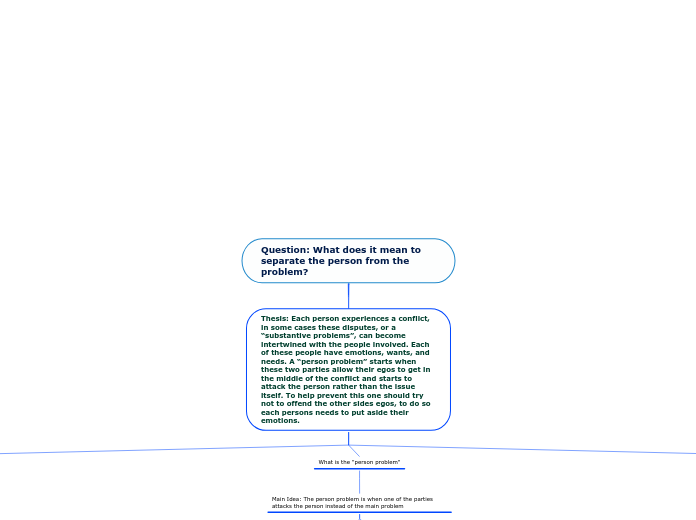Question: What does it mean to separate the person from the problem?
Thesis: Each person experiences a conflict, in some cases these disputes, or a “substantive problems”, can become intertwined with the people involved. Each of these people have emotions, wants, and needs. A “person problem” starts when these two parties allow their egos to get in the middle of the conflict and starts to attack the person rather than the issue itself. To help prevent this one should try not to offend the other sides egos, to do so each persons needs to put aside their emotions.
What does it mean to separate the person from the problem?
Main Idea: to separate the person from the problem the person should start a relationship w the opposing side, this lets the other side know you acknowledge their wants and emotions
Parties may tend to lash out at each other, when in reality, they should be trying to come together and attack the problem itself.
For example: if one person wants to eat at Olive Garden and another person wants to eat at Chili’s, separating the person from the problem would mean focusing only on the main problem (where to eat) without becoming distracted by previous conflicts or ongoing tensions in the relationship.
Separating the person from the problem would not include referencing where the pair has eaten before, who made this decision, or who usually decides where they eat.
People from each side should focus on the other's interests and try to find a mutual compromise.
What is the "person problem"
Main Idea: The person problem is when one of the parties attacks the person instead of the main problem
What is a person?
A person is an individual with emotions, feelings, wants, needs, and ego
An ego is a person's sense of self-esteem or self-importance.
When some feels like they have been attacked they can give off passive aggressiveness or be defensive in an arguement
The person may feel upset and now have a negative view of themselves because their ego has shrunk
Don’t focus on yours or the other sides imperfections, not one person is truly perfect.
Emotions: natural instinctive state of mind deriving from one's circumstances, mood, or relationships with others
In a "person problem" its attacking the person, but attacking the problem
Put yourself in the other person's shoes, and making sure you are understanding the other person's point of view
If you want to influence them, you also need to understand empathetically their point of view.
Understanding their point of view is not the same as agreeing with it. Try and be open minded about their side of the problem.
Conclusion: the other side feels as though their needs and emotions have been acknowledged and met, the person should strike the problem instead of the people
What is the substantive problem?
Main Idea: The "substantive problem" is a conflict that is trying to be solved, but can't come to a solution
A person can tend to think the substantive problem lies in conflicting positions. Other people in a dispute can tend to negotiate using positions.
The problem that is being argued is usually between two closed-minded people.
involves what the people involve their wants and needs
